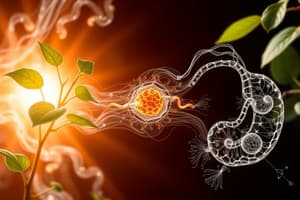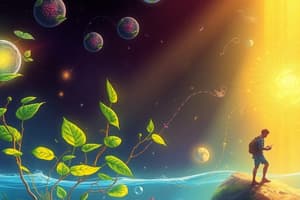Podcast
Questions and Answers
Where do light-dependent reactions occur?
Where do light-dependent reactions occur?
- Mitochondria
- Cytosol of cell
- Stroma of chloroplasts
- Thylakoid membranes of chloroplasts (correct)
What is the byproduct of water oxidation in light-dependent reactions?
What is the byproduct of water oxidation in light-dependent reactions?
- Glucose
- ATP
- CO2
- Oxygen (correct)
Where is pyruvate converted into acetyl-CoA?
Where is pyruvate converted into acetyl-CoA?
- Stroma of chloroplasts
- Thylakoid membranes of chloroplasts
- Cytosol of cell
- Mitochondria (correct)
What is the final electron acceptor in oxidative phosphorylation?
What is the final electron acceptor in oxidative phosphorylation?
Where is glucose broken down into pyruvate?
Where is glucose broken down into pyruvate?
Flashcards are hidden until you start studying
Study Notes
Photosynthesis Process
- Light-Dependent Reactions
- Occur in thylakoid membranes of chloroplasts
- Light energy excites electrons, which are used to generate ATP and NADPH
- Water is oxidized, releasing oxygen as a byproduct
- Light-Independent Reactions (Calvin Cycle)
- Occur in stroma of chloroplasts
- ATP and NADPH from light-dependent reactions are used to fix CO2 into glucose
- Glucose is produced and stored in plant cells
Respiration Process
- Glycolysis
- Occurs in cytosol of cell
- Glucose is broken down into pyruvate, producing ATP and NADH
- Citric Acid Cycle (Krebs Cycle)
- Occurs in mitochondria
- Pyruvate is converted into acetyl-CoA, which enters the cycle
- ATP, NADH, and FADH2 are produced
- Oxidative Phosphorylation
- Occurs in mitochondria
- NADH and FADH2 from citric acid cycle are used to generate ATP through electron transport chain
- Oxygen is the final electron acceptor, producing water as a byproduct
Photosynthesis Process
- Occurs in thylakoid membranes of chloroplasts
- Light energy excites electrons, generating ATP and NADPH
- Water is oxidized, producing oxygen as a byproduct
Light-Independent Reactions (Calvin Cycle)
- Occurs in stroma of chloroplasts
- ATP and NADPH from light-dependent reactions are used to fix CO2 into glucose
- Glucose is produced and stored in plant cells
Respiration Process
Glycolysis
- Occurs in cytosol of cell
- Glucose is broken down into pyruvate, producing ATP and NADH
Citric Acid Cycle (Krebs Cycle)
- Occurs in mitochondria
- Pyruvate is converted into acetyl-CoA, entering the citric acid cycle
- ATP, NADH, and FADH2 are produced
Oxidative Phosphorylation
- Occurs in mitochondria
- NADH and FADH2 from citric acid cycle are used to generate ATP through electron transport chain
- Oxygen is the final electron acceptor, producing water as a byproduct
Studying That Suits You
Use AI to generate personalized quizzes and flashcards to suit your learning preferences.




